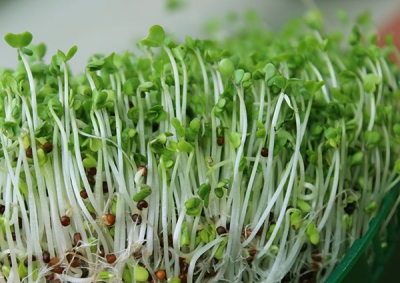How do Seeds sprout?
Seeds sprout when favourable temperature (15.38°C), enough oxygen and moisture are available. They absorb large amounts of water and swell. The moisture content of cells rises from 10 per cent to 90 per cent or more. The plant growth hormone, indole acetic acid which controls and promotes various stages of growth, sets into action the various life processes. Cells at the growing tips of the embryo within the seed divide rapidly and the primary root emerges through the soft seed coat. Further changes follow leading to emergence of the shoot Soil is not always necessary for the sprouting of seeds. Seeds will sprout in moist sand; saw dust, peat mosses, cloth or even paper if favourable conditions are available.


 Lakes which appear frozen from the top never freeze completely. Only the top layer freezes and a thick layer of ice floats on water which remains liquid below and in which fishes and other aquatic animals survive. With the onset of winter water starts cooling. As it cools, it shrinks in volume and become denser, but only until it reaches 4°C. Below that temperature water expands and its density drops. This comparatively lighter water moves up and finally at 0°C turns into ice. Since the density of ice is less than that of water, the ice floats. Also, ice being a very poor conductor of heat, further cooling of the water below it stops. Thus the temperature of water below the ice layer remains at 4°C and fishes survive in it.
Lakes which appear frozen from the top never freeze completely. Only the top layer freezes and a thick layer of ice floats on water which remains liquid below and in which fishes and other aquatic animals survive. With the onset of winter water starts cooling. As it cools, it shrinks in volume and become denser, but only until it reaches 4°C. Below that temperature water expands and its density drops. This comparatively lighter water moves up and finally at 0°C turns into ice. Since the density of ice is less than that of water, the ice floats. Also, ice being a very poor conductor of heat, further cooling of the water below it stops. Thus the temperature of water below the ice layer remains at 4°C and fishes survive in it. No animal can see in total darkness. However, some animals are capable of making use of faint light of the surrounding. Members of the cat family, like the tiger and cat or other nocturnal animals can see in near darkness because of the presence of large number of cells called rod cells in the retina. These cells are sensitive to dim light and help the animal to see in near darkness.
No animal can see in total darkness. However, some animals are capable of making use of faint light of the surrounding. Members of the cat family, like the tiger and cat or other nocturnal animals can see in near darkness because of the presence of large number of cells called rod cells in the retina. These cells are sensitive to dim light and help the animal to see in near darkness.


 Spiders spin webs as a means of trapping insects. They have special organs called spinnerets located in their abdomen. Spinnerets are muscular organs which release the thread, independently of one another. Most spiders are equipped with three pairs of spinnerets. Each pair is fed by several silk glands which produce a sticky liquid that can be drawn into fine threads. The sticky liquid turns into a thread by solidifying on exposure to air.
Spiders spin webs as a means of trapping insects. They have special organs called spinnerets located in their abdomen. Spinnerets are muscular organs which release the thread, independently of one another. Most spiders are equipped with three pairs of spinnerets. Each pair is fed by several silk glands which produce a sticky liquid that can be drawn into fine threads. The sticky liquid turns into a thread by solidifying on exposure to air.